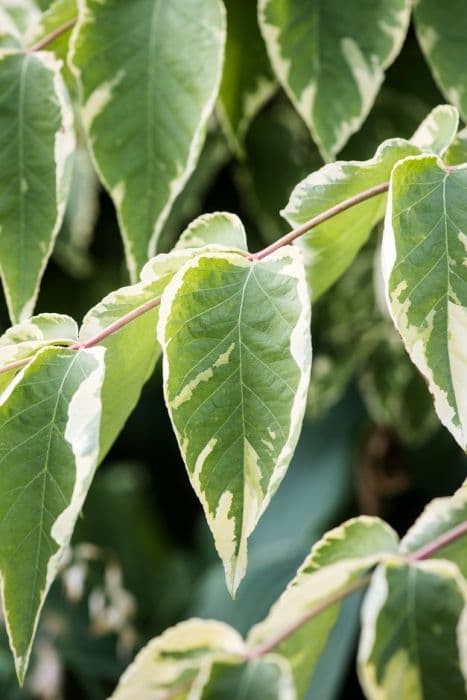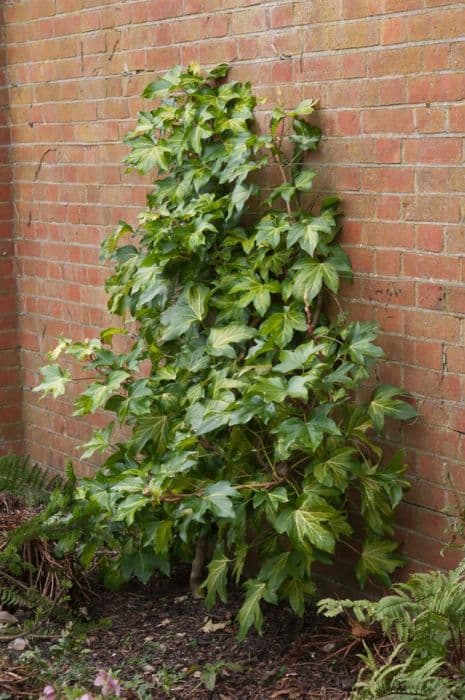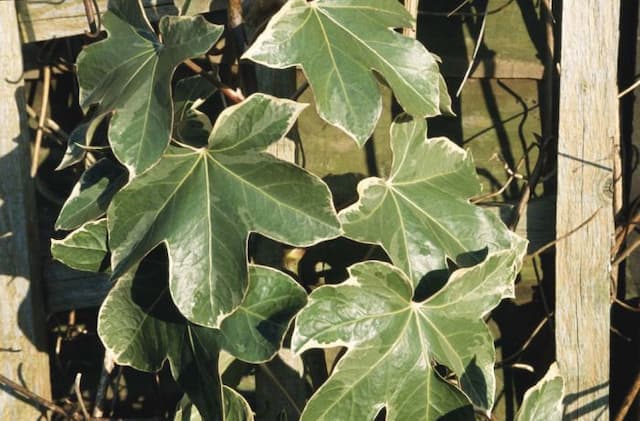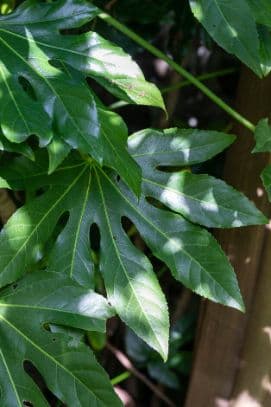Variegated Ivy Hedera helix 'Minor Marmorata' (v)

ABOUT
Hedera helix 'Minor Marmorata' (v), commonly known as English ivy, is a visually appealing plant that boasts variegated foliage. The leaves of this cultivar are smaller and display a heart-shaped or three-pointed ivy form. They are typically green in color and are adorned with creamy-white or yellowish mottling throughout, giving them a marbled appearance. This variegation can create a striking contrast, making the plant stand out in any setting. English ivy's leaves have a glossy finish which adds to their ornamental value. Their vines can trail or climb, exhibiting flexibility in their growth habit, and they often form a lush curtain of greenery where allowed to flourish. This variegation may be more pronounced when the plant is grown in brighter light conditions, yet English ivy is known for its tolerance to varied light environments. The pattern and intensity of the variegation can vary, and this patterning can make the plant particularly striking. It can be commonly found adding a decorative touch to walls, trellises, or as ground cover in landscape designs. English ivy is also a favorite for indoor use, often utilized in hanging baskets or as a feature in container compositions. The attractive variegated leaves can add a touch of elegance to any interior space. The color variation and the leaf shapes are key elements in the plant's ornamental appeal.
About this plant
 Names
NamesFamily
Araliaceae
Synonyms
Variegated Ivy, Ornamental Ivy, English Ivy
Common names
Hedera helix 'Minor Marmorata'.
 Toxicity
ToxicityTo humans
English Ivy, including the variety 'Minor Marmorata', contains saponins which can be toxic to humans if ingested. Symptoms of poisoning from consuming parts of this plant may include abdominal pain, vomiting, and diarrhea. In some cases, contact with the skin can lead to dermatitis. It is important to keep English Ivy out of reach of children who might be tempted to eat its leaves or berries.
To pets
English Ivy is also toxic to pets, such as cats and dogs. Ingestion of the plant can cause vomiting, diarrhea, excessive salivation, and abdominal pain. In severe cases, ingestion could lead to difficulty in breathing or even coma. It is crucial to prevent pets from chewing on or ingesting any part of the plant to avoid potential poisoning.
 Characteristics
CharacteristicsLife cycle
Perennials
Foliage type
Evergreen
Color of leaves
Variegated
Height
50 feet (15 meters)
Spread
6 feet (1.83 meters)
Plant type
Climber
Hardiness zones
5
Native area
Europe
Benefits
 General Benefits
General Benefits- Visual Appeal: Enhances the aesthetic of any space with its variegated foliage.
- Low Maintenance: Requires minimal care, making it ideal for busy owners.
- Versatility: Adapts to a variety of growing conditions, both indoors and outdoors.
- Durability: Tolerates neglect, recovering well from occasional lapses in care.
- Growth Habit: Excellent for ground cover, walls, and trellis climbing.
- Seasonal Interest: Provides year-round greenery in most climates.
- Wildlife Support: Offers shelter and sometimes food for birds and insects.
- Temperature Regulation: Can help to moderate the temperature of its surroundings.
- Erosion Control: Roots stabilize soil and can help prevent erosion.
- Cultural Significance: Used in many cultures for decoration during festivals and holidays.
 Medical Properties
Medical Properties- This plant is not used for medical purposes.
 Air-purifying Qualities
Air-purifying QualitiesThis plant is not specifically known for air purifying qualities.
 Other Uses
Other Uses- As a natural dye: The English ivy can be used to produce natural dyes for fabrics and yarn. The leaves contain pigments that can create varying shades of tan, green, and brown.
- In terrariums: The small leaves of 'Minor Marmorata' are ideal for creating miniature landscapes within glass terrariums, providing a lush, green backdrop for other small plants and decorative elements.
- As a camouflage: English ivy can be grown against unsightly structures, such as utility boxes or old fences, to help them blend into the landscape.
- For topiary art: Due to its climbing and vining nature, it can be trained over a topiary form to create living sculptures in the garden.
- In film and theater: The leaves can be used on sets to create a mood or setting, such as an ancient ruin or a mysterious, overgrown location.
- For educational purposes: English ivy's growth patterns and impact on structures can be studied to understand the effects of invasive species in certain regions.
- As a filler in floral arrangements: Its trailing vines and lush foliage make it an attractive addition to bouquets and table centerpieces.
- Craft projects: The vines and leaves can be incorporated into wreaths, garlands, or other decorative crafts for home decor.
- In artistic photography: Photographers may use English ivy as a live prop to add texture and a sense of age or natural beauty to their compositions.
- For erosion control: Though it can become invasive, in controlled situations, English ivy can be used to stabilize soil on slopes and prevent erosion.
Interesting Facts
 Feng Shui
Feng ShuiThe English Ivy is not used in Feng Shui practice.
 Zodiac Sign Compitability
Zodiac Sign CompitabilityThe English Ivy is not used in astrology practice.
 Plant Symbolism
Plant Symbolism- Connection: English Ivy, like other ivies, often symbolizes connection and friendship because of its tendency to cling and grow along walls and trees, representing the interconnectedness of relationships.
- Eternity and Fidelity: The evergreen nature of English Ivy stands for eternal life and fidelity. It remains green throughout the year, reflecting steadfastness and unwavering loyalty.
- Protection: Historically, ivy was believed to protect against negative energy and evil spirits. Its dense growth was thought to act as a barrier against misfortune.
- Survival and Resilience: English Ivy is known for its hardiness and ability to thrive in challenging conditions, making it a symbol of survival and resilience.
- Wedding and Celebration: It is often used in wedding bouquets and decorations to represent lasting love and commitment, echoing its qualities of endurance and dependability.
 Water
WaterEnglish Ivy should be watered when the top inch of the soil feels dry to the touch, which typically means once every 7 to 10 days depending on environmental conditions. It is critical not to overwater, as this can lead to root rot. You should provide enough water to saturate the soil thoroughly, approximately one gallon for a medium-sized pot. During the winter months, reduce watering to every 10 to 14 days as plant growth naturally slows. Always check the soil moisture before watering and adjust your schedule accordingly to prevent overwatering.
 Light
LightEnglish Ivy thrives in bright, indirect light but can also adapt to low light conditions. It should be placed in a spot where it will receive filtered sunlight, such as near a north-facing window or a few feet away from an east or west-facing window. Avoid placing it in direct sunlight, especially during the hot summer months, as this can scorch the leaves.
 Temperature
TemperatureEnglish Ivy prefers a temperature range between 50°F and 70°F for optimal growth. It can withstand temperatures as low as 10°F and as high as 90°F, but prolonged exposure to these extremes can be damaging. The ideal conditions would be a consistently cool environment with adequate ventilation to prevent overheating.
 Pruning
PruningPrune English Ivy to control its growth, shape the plant, and encourage fuller, bushy growth. The best time to prune is in the spring or early summer. However, light pruning can be done any time of the year as needed. Cut back overgrown stems, and remove any dead or damaged foliage every few months to keep the plant tidy.
 Cleaning
CleaningAs needed
 Soil
SoilThe English Ivy 'Minor Marmorata' prefers a well-draining soil mix rich in organic matter. A mix of peat, compost, and perlite or sand can provide the necessary drainage and nutrients. The pH should be slightly acidic to neutral, ranging from 6.0 to 7.5.
 Repotting
RepottingEnglish Ivy 'Minor Marmorata' should be repotted every two to three years or when it outgrows its current pot. Spring or early summer is the best time to repot this plant to allow it to settle before the growth season.
 Humidity & Misting
Humidity & MistingEnglish Ivy 'Minor Marmorata' thrives in moderate to high humidity levels, ideally between 40% and 60%. If the air is too dry, leaves may dry out; consider using a humidifier or misting the plant to maintain adequate humidity.
 Suitable locations
Suitable locationsIndoor
Bright indirect light, keep soil moist, regular misting.
Outdoor
Part shade to full shade, shelter from harsh sun.
Hardiness zone
5-11 USDA
 Life cycle
Life cycleCommonly known as the variegated English ivy, Hedera helix 'Minor Marmorata' begins its life as a seed which, once germinated, develops into a juvenile form characterized by lobed leaves and a creeping growth habit. This stage can last for several years as the plant spreads across the ground or climbs surfaces using aerial rootlets. As it matures, the English ivy enters the adult vegetative stage, producing unlobed, ovate leaves and eventually flowers when proper environmental conditions are met, typically requiring several years of growth before flowering occurs. Following pollination, the plant produces berry-like fruits that contain seeds, which are then dispersed by birds and other animals, leading to new plants starting the cycle anew. Throughout its life, the variegated English ivy may revert from adult back to juvenile form if environmental conditions are not favorable for flowering and fruiting. The plant is perennial and can survive for many years, going through these life stages multiple times.
 Propogation
PropogationPropogation time
Spring-Early Summer
The most popular method for propagating English Ivy 'Minor Marmorata' is through stem cuttings. You can take cuttings during spring or early summer when the plant is actively growing. Select healthy, non-flowering stems and cut a 4 to 6 inch (10 to 15 centimeters) length, making sure each cutting has at least one set of leaves. Remove the lower leaves and dip the cut end into rooting hormone powder to encourage root formation. Insert the cutting into a pot filled with a mixture of peat and perlite or sand, ensuring the leaf nodes where you removed the leaves are buried. Keep the soil moist but not soggy and place the pot in a warm, bright spot out of direct sunlight until roots develop, which generally takes a few weeks. Once the cuttings have rooted, you may transplant them to their permanent location.









